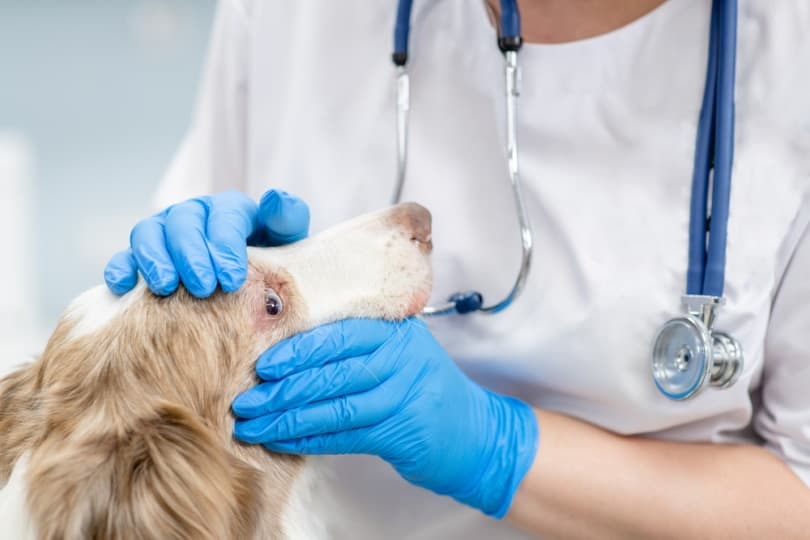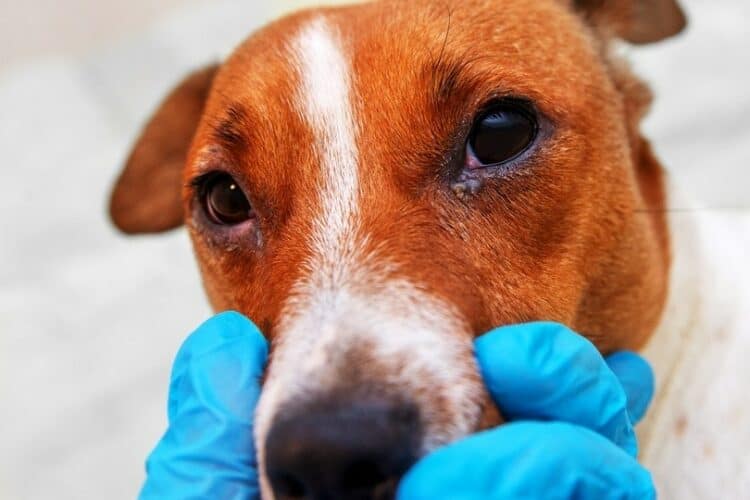Have you ever looked in the mirror and noticed that your eyes are bloodshot? Well, the same thing can occur in your dog’s eyes. Perhaps you and your dog share similar symptoms and causes, or perhaps they’re vastly different. Thankfully, most of the reasons for bloodshot eyes are typically very minor, with only a few requiring immediate attention from the veterinarian.
To ease your mind, we’ve listed five possible reasons why your dog’s eyes may be bloodshot. Go through the symptoms of each to identify whether your dog is displaying those particular symptoms or not so that you can know whether you’re dealing with something serious or minor.
The 5 Possible Reasons My Dogs Eyes Are Bloodshot
1. Dry Eye
Dry eye is an extremely uncomfortable and often painful condition that develops when the eye can’t lubricate properly because of an unstable tear film. It can occur because of tears evaporating too quickly off the surface of the eye, or not enough tears being produced. The condition typically affects both eyes, but one eye can often feel worse than the other.
Dry eye can be caused by a fault in the dog’s immune system or by hormonal problems. Many dogs and people alike suffer from dry eye, which can be managed with treatment. However, if left untreated, your dog will suffer from eye ulcers, scarring, and ultimately the loss of their eye/s.
Symptoms to look out for are sticky discharge, redness, painful eyes that result in your dog blinking excessively or pawing at their eyes, and frequent eye infections.
2. Allergies
Just like people, dogs can be allergic to dirt, grass, insects, trees, pollen, dust, etc., which can irritate their eyes. Although this reaction can be seen all year round, it’s not as common as during spring and summer.
The allergens trigger the mucous membranes around your dog’s eyes, which causes inflammation, redness, discharge, and squinting. To soothe your dog’s itchy eyes, the veterinarian will likely give you eye drops to place in their eyes according to their instructions.

3. Trauma
Trauma is another possible reason your dog has bloodshot eyes. Trauma doesn’t always occur due to impact but can be caused by something less ominous, such as a tree branch or a small object flying into their eye while their head is out a vehicle’s window. Often trauma starts small but, when left untreated, can develop into an infection.
Symptoms of eye injuries in dogs are excessive blinking, a bloodshot eye, teary eye, squinting, and being unable to open or close the eye properly. Treatment can be as basic as antibiotic eye drops or as serious as surgery. The extent of the injury will be determined by the veterinarian after an eye examination has been performed.
4. Uveitis
Uveitis is inflammation in the uvea, which is made up of several structures in the eye. Depending on where the inflammation in the uvea is will determine the type of uveitis present. Very often, the cause of the uveitis is unknown. However, if it recurs often, it can be an indication of a more serious health condition.
However, uveitis is commonly present if a dog has an infection, metabolic disease, high blood pressure, immune-mediated, and when trauma has happened to the eye. Uveitis will cause pain in the affected eye, and your dog will try to keep it closed as bright lights often worsen the pain. You’re likely to notice tearing, redness, bleeding, or cloudiness in the eye.
Often, the uveitis in the eye clears up relatively quickly once treated, but the underlying issue may take longer to resolve, depending on what it is.
5. Glaucoma
Glaucoma is a serious eye condition that often leads to blindness. It typically starts in one eye, but usually, both eyes will be affected. Glaucoma is high pressure within the eye that can occur suddenly or progress over months or years.
If the pressure in your dog’s eye suddenly increases, they’ll experience a lot of pain, and you’ll notice bloodshot eyes, squinting, and lethargy. You should take your dog to the veterinarian immediately as they’ll lower the pressure in the eye before damage occurs.
The type of glaucoma that causes a slow pressure increase is harder to notice as it often isn’t accompanied by symptoms and is generally only noticed once the damage has been done. Unfortunately, vision loss due to this condition cannot be restored. Annual checkups are an essential preventative method for vision loss.
Final Thoughts
Unfortunately, many causes of bloodshot eyes in your dog have similar symptoms, making it hard to differentiate between them. It is necessary to take your dog in to be seen by a veterinarian if you notice any of the symptoms listed. Annual vet checkups are important for catching eye problems early to slow down the damage.
Featured Image Credit: Alexandr Jitarev, Shutterstock














